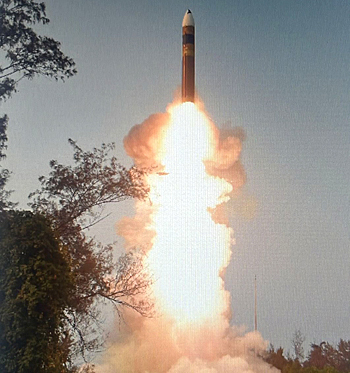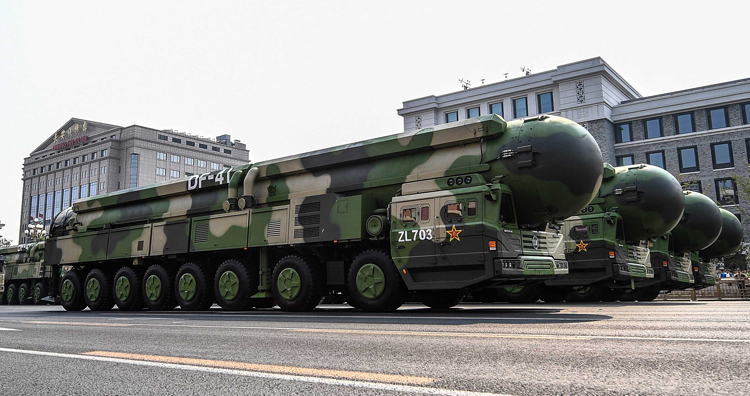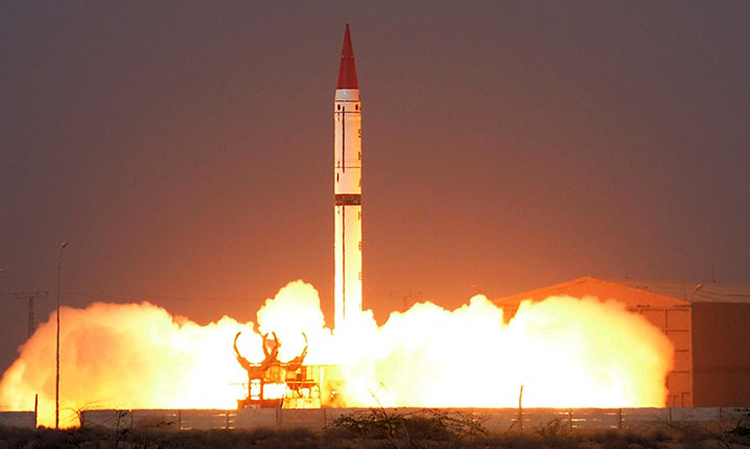INDIAN ARMED FORCES CHIEFS ON
OUR RELENTLESS AND FOCUSED PUBLISHING EFFORTS

SP Guide Publications puts forth a well compiled articulation of issues, pursuits and accomplishments of the Indian Army, over the years

I am confident that SP Guide Publications would continue to inform, inspire and influence.

My compliments to SP Guide Publications for informative and credible reportage on contemporary aerospace issues over the past six decades.
Divyastra Launched
With implications extending beyond the South Asian region,India's successful test of the Agni-5 ballistic missile equipped with MIRV technology marks a significant leap in the nation's strategic capabilities
 |
The Author is Former Director General of Information Systems and A Special Forces Veteran, Indian Army |

On March 11, 2024, India tested its most formidable Agni-5 ballistic missile with a multiple warhead capability for the first time over the Bay of Bengal, in a major boost for the country's credible strategic deterrence, especially against China – the 'Divyastra', the Agni-5 missile with Multiple Independently Targetable Re-entry Vehicle (MIRV) technology. With the successful Mission Divyastra, India has joined the select group of nations that have MIRV capability although more MIRVed missile tests would be needed before India operationally deploys this new capability.
Divyastra is configured to carry, either a single megaton weapon, or as many as eight smaller yield nuclear warheads and decoys. For the test launch, the three MIRVed warhead variant was used, with each of the warheads being released at one second intervals during which time the missile travelled 4.4-5 km. Its elliptical target zone is calculated as roughly 50 km by 150 km. The MIRVed missile test demonstrates India's success in developing re-entry vehicles small enough to arm a ballistic missile with multiple warheads. The Divyastra system is equipped with indigenous avionics systems and high-accuracy sensor packages, which ensure that the re-entry vehicles reach the target points within the desired accuracy. This would ensure that a single missile can deploy multiple warheads at different locations.
Proud of our DRDO scientists for Mission Divyastra, the first flight test of indigenously developed Agni-5 missile with Multiple Independently Targetable Re-entry Vehicle (MIRV) technology.
— Narendra Modi (@narendramodi) March 11, 2024
Prime Minister Narendra Modi posted on X: "Proud of our DRDO scientists for Mission Divyastra, the first flight test of indigenously developed Agni-5 missile with Multiple Independently Targetable Re-entry Vehicle (MIRV) technology." A government official told media, "The capability is an enunciator of India's growing technological prowess."

During the 2008 India-US nuclear civilian cooperation deal, America's George W. Bush Administration ensured India would not become a thermonuclear power. The deal was negotiated from the Indian side by S. Jaishankar, then Joint Secretary (America) in MEA who is currently the External Affairs Minister. It carried the explicit threat of termination of the deal, if India resumed nuclear testing; achieving America's express arms control goal of "capping and freezing" India's strategic weapons at the sub-thermonuclear level.
A MIRV is a ballistic missile payload designed for Exo-Atmospheric deployment, housing multiple warheads, each capable of targeting distinct objectives. While primarily associated with intercontinental ballistic missiles equipped with thermonuclear warheads, the concept extends beyond strict limitations. An intermediate variant, the Multiple Re-entry Vehicle (MRV) missile, disperses multiple warheads without individual targeting.
Deployment of MIRV can enhance first-strike proficiency for strategic forces and also provide greater target damage for a given thermonuclear weapon payload. Moreover, as it can release multiple warheads, it serves the purpose of a cluster munition, as it reduces the number of missiles and launch facilities required. With the MIRV, the effectiveness of an anti-ballistic missile system that relies on intercepting individual warheads is also reduced.
MIRVs also have an important role in defeating the missile defences of the enemy since a salvo of multiple warheads would be able to overwhelm and penetrate the ballistic missile defence interceptors
India has been developing capabilities to intercept hostile ballistic missiles both inside and outside the earth's atmospheric limits. India's Agni-1 to Agni-4 missiles have ranges from 700 km to 3,500 km and have already been deployed. In recent years, India has conducted a series of tests of the Agni-5missile. In October 2021, the Ministry of Defence (MoD) had announced the successful launch of the surface-to-surface ballistic missile and said the launch was carried out on October 27 from the Dr APJ Abdul Kalam Island, Odisha.
The Agni-5 missile, which uses a three-stage solid-fuelled engine, is capable of striking targets at ranges up to 5,000 km with a very high degree of accuracy. The successful test of Divyastra (Agni-5) is being viewed in line with India's stated policy to have 'credible minimum deterrence' that underpins the commitment to 'No First Use'. MIRVed missiles will enhance survivability of the Indian nuclear arsenal against an enemy's first strike. MIRVs also have an important role in defeatingthe missile defences of the enemy since a salvo of multiple warheads would be able to overwhelm and penetrate the ballistic missile defence interceptors. The Divyastra missile can bring almost the entire Asia including the northernmost part of China as well as some regions in Europe under its striking range.
Pakistan is also reportedly experimenting with MIRV technology, possibly with Chinese assistance, although there are no concrete pointers to support this. The US, the UK and France already have MIRV technology on their Submarine-Launched Ballistic Missiles (SLBMs). China has MIRV technology as part of its Intercontinental Ballistic Missiles (ICBMs). Russia has both MIRVed ICBMs and SLBMs.

According to estimates, India has 164 nuclear warheads and Pakistan 170. China of course has built a formidable arsenal of long-range missiles, with its Dong Fang-41 (DF-41) ICBM having a range of 12,000 km. Significantly, China already has more than 500 operational nuclear warheads and is fully on course to reach the number of over 1,000 nuclear warheads by year 2030. Recent satellite imagery shows China is also constructing over 300 new missile silos.
According to estimates, India has 164 nuclear warheads and Pakistan 170. China of course has built a formidable arsenal of long-range missiles, with its Dong Fang-41 (DF-41) ICBM having a range of 12,000 km.
Notably, China sent its second research vessel to monitor the test flight of Divyastra Agni-5 missile, in addition to the first that was already anchored off the coat of Maldives. According to the maritime analytics provider 'Maritime Traffic', just weeks before the successful test of Agni-5, Chinese research vessel 'Xiang Yand Hong 01' departed from the Chinese port of Qingdao on February 23, 2024. The 5,425 tonne entry into the Bay of Bengal on March 10, 2024 (a day before the Divyastra test) was reported by open-source intelligence expert Damien through a tweet on X. The Xiang Yand Hong 01 is reportedly now less than 260 nautical miles (about 480 km) off the coast of Vishakhapatnam, which is believed to have the base of India's nuclear-powered ballistic missiles.

China is naturally concerned about Divyastra which can cover entire China, with its 5,000 km strike range, and can fire multiple nuclear warheads. Moreover, the system provided the capability of firing salvos of decoys, in addition to actual warheads, to fool the enemy defence systems. All the Agni series of missiles inducted by the tri-service Strategic Forces Command can now carry one single missile with multiple warheads. The Divyastra test sent a signal to Beijing at a time when China's National People's Congress was concluding.
Director of Nuclear Information Project, Federation of American Scientists Hans Kristensen wrote in 2021 that if India succeeds in developing an operational MIRV capability for its ballistic missiles, it will be able to strike more targets with fewer missiles. He further wrote if either country believed that India could potentially conduct a decapitating or first strike against Pakistan, a serious situation could potentially go nuclear with little advance warning. Indian missiles with MIRVs would become targets for an adversary (China?) to destroy before they could be launched to reduce the damage India could inflict.





